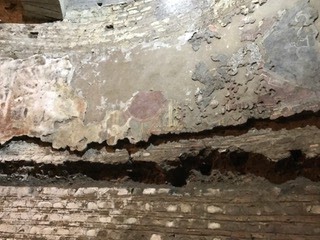As he lay dying in the stables to which he had been condemned to labor, the aged Pope Marcellus would hardly have imagined that this church in his name would one day stand on this site. Elected in 308, he was faced almost immediately with the issue of the re-admittance to communion of those who had denied the faith during the persecutions - to which issue he responded by upholding the traditional period of penance. Arrested some months later, he was made to work in the imperial stables just off the main road which is now the Via del Cross. Some traditions say that this had been the location of an oratory consecrated by him, turned into stables by the Romans to humiliate him and the Church. After suffering in the difficult labor, he would die shortly thereafter. His remains are venerated here - buried under the high altar.


In the late fourth and early fifth century, the first church was built here in his honor as part of a program to replace house churches with larger structures. This woulds soon enter into history for the dubious honor of being the seat of the antipope Boniface in 418, a role it would again serve in the early twelfth century when another antipope occupied the church. A baptismal font, built sometime soon after the fifth century, was present here, of which the remains were discovered in 1912. This marks the church as being of some significance, since the ordinary place of baptism was still the Lateran.

Adrian I undertook repairs here in the late eighth century, and sometime in the early twelfth century the church was completely demolished and replaced with a new one. However, a fire on 23 May, 1519 would cut the life of this church short - with the most significant survivor of the disaster being a crucifix, now venerated in a side chapel. This crucifix is brought to St. Peter's Basilica during jubilee years to be venerated by the faithful.
There was a lovely prayer available to pray before this crucifix. I offer it here for you to spiritual join me in this pilgrimage:
I kneel at your feet, O Crucified Jesus, to adore and thank you for the gift of your life to me.
You wipe away my tears, you are my support in the difficult moments, you listen to my complaint; you accept my paint together with yours. You know my tired heart, happy only to love you, and you help me to accept the difficulties of life. Often I don't think of your pain and I come to present mine to you, but you set your hands on me and console me, you take care of my wounds with your love, you welcome me into your arms and make me feel your heart which burns of love for me.
I knock now at your heart asking you this grace...
If what I ask is according to your will, grant it to me, O Lord. O Crucified Jesus, your Mother Mary is near to you; welcome all suffering people and be their consolation and hope. Amen.
The most holy Crucifix remained providential intact after the fire that, in the night between the 22nd and 23rd of May, 1519, destroyed the ancient Basilica. It is an ancient, majestic and expressive wooden sculpture of the XIV century covered with gold dust.
Beginning in 1525 and continuing for the next 70 years, the work of reconstruction took place, with the orientation of the church being reversed so that the facade faced the Via del Cross. The later years of the 17th century would see some final modifications to the site, as the Romanesque campanile was demolished and the current facade, designed by Carlo Fontana, was constructed. The interior was restored in the 1860's, and it is in this form that the building comes down to us today.


































